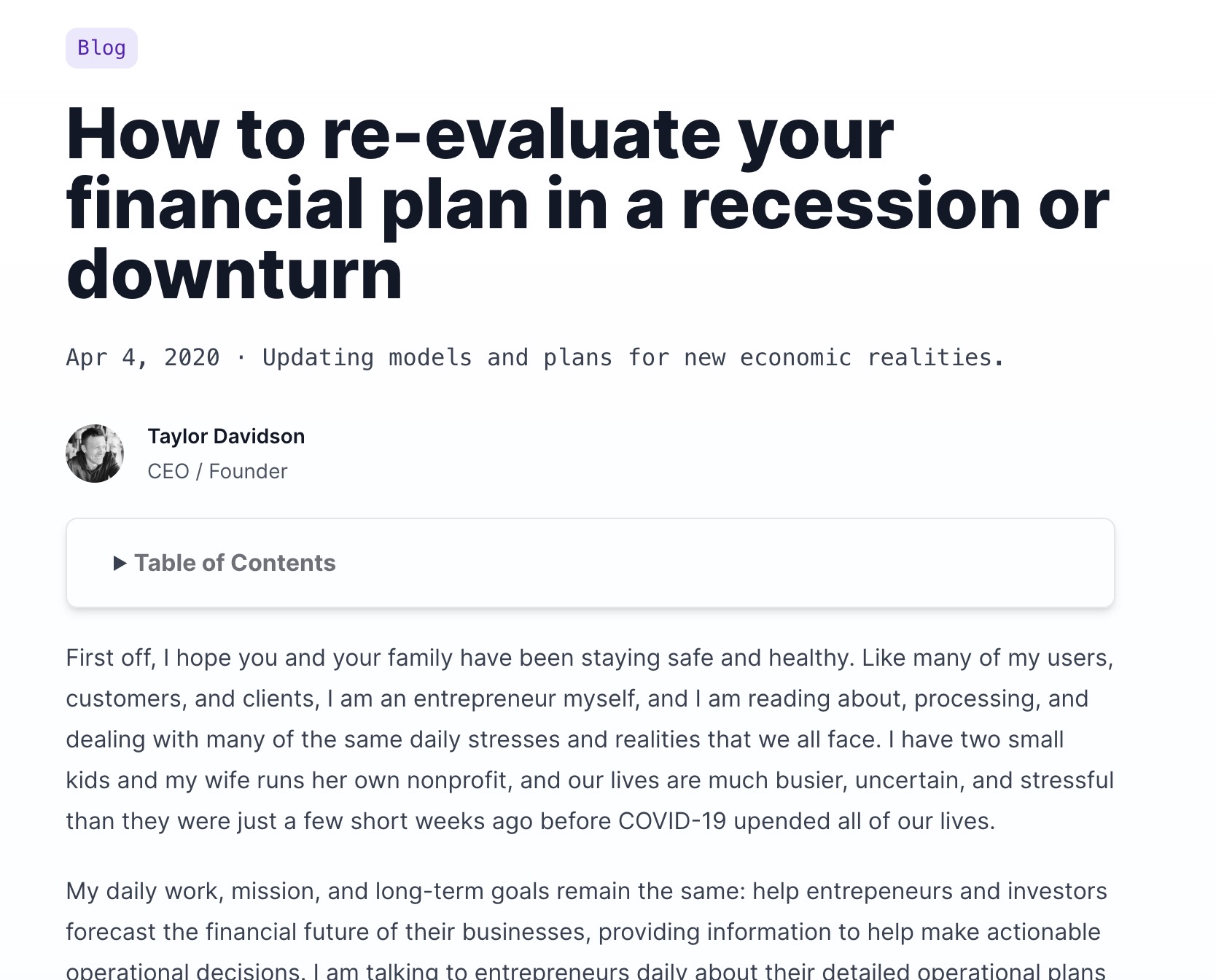First off, I hope you and your family have been staying safe and healthy. Like many of my users, customers, and clients, I am an entrepreneur myself, and I am reading about, processing, and dealing with many of the same daily stresses and realities that we all face. I have two small kids and my wife runs her own nonprofit, and our lives are much busier, uncertain, and stressful than they were just a few short weeks ago before COVID-19 upended all of our lives.
My daily work, mission, and long-term goals remain the same: help entrepeneurs and investors forecast the financial future of their businesses, providing information to help make actionable operational decisions. I am talking to entrepreneurs daily about their detailed operational plans to help plan out the options they have and decisions they face, and I will continue to do that. The impacts of COVID-19, while on a scale far larger than almost all of us have ever faced in our careers, still relies on the same fundamental analysis and forecasting I have always done with entrepreneurs, and I am here to help. Whether you have purchased or used a Foresight model or not, feel free to call, email, or schedule a chat →
How I can help in your COVID-19 planning
Here's a few specific ways I can help with your COVID-19 planning:
- In the USA, there is a lot of noise about the CARE Act, the Payroll Protection Plan (PPP), Economic Injury Disaster Loan (EIDL), and shifting guidance in how the laws and programs are being implemented. I am reading all of the guides and details about the new regulations every day, and I am happy to help you think about whether they make sense for you and how to adjust your forecast or plan for them. All of the Foresight models from the Starter and above are prebuilt to create cash flow forecasts, and these grants and loans are simple to input to the models using the existing structure.
- I do not plan on writing a guide to all of the new laws and options, but will point you to a few I have found personally helpful. Kyle Westaway's The Entrepreneur's COVID-19 Playbook is helpful to understand the economic and legal implications, IndieVC's Intro is a good guide to the PPP and EIDL, and can help you find a lender through their partnership with Lendio. MicroConf released a good overview of the programs, Viktoria Harrison released a Nonprofit Survival Guide that's helpful for startups as well. This outline of the tactical details to applying for a PPP loan is helpful. The specific guidance on the programs is changing, and I expect there to be additional legislation this year as the economic fallout from the pandemic continues, knock-on effects upon knock-on effects reverberating through the economy. I plan on sharing more as they come out.
- There is also a lot of anxiety created by the feeling of there being a finite amount of money budgeted to these programs, and a rush to be first in line to get a share before it runs out. Plans before panic. Right now, it is important to get a handle on cash and spending, and develop a plan for a number of scenarios so that you can decide on your funding options appropriately.
- Planning for downturns and scenarios is built into all of my tools. All of the Foresight models are built to be used for scenario analysis and to evaluate how changes in our assumptions or variables impact the entire business. Last week I quietly released a new feature into the Standard Financial Model called Variances that can help create quick range-based scenario forecasts. I also recommend checking out Causal, a browser-based modeling tool that is built to create probability-weighted forecasts using range-based inputs, it's a great tool for you to build your own analyses of how changes in your core assumptions (e.g. growth, churn, average revenues) can impact key business metrics. [1] Questions about using any of these tools for your business, call, email, or schedule a chat →
How to re-evaluate your forecasts and options
This is not a normal situation. Many of us are dealing with changes to our work lives that we have never seen or experienced in our careers, save those of us that have previously worked through wars, epidemics, or natural disasters. If they were able to stay open, all companies have had to instantly create work-from-home infrastructures from scratch [2], furlough or lay off key parts of their staffs, end or pause projects, shift priorities, and change their product offerings, creating massive disruption to how their businesses and people. None of that is easy.
In that environment, and combined with a rush to take advantage of new government loans and grants, it's easy to get distracted. Don't. The fundamental focus for most entrepreneurs is a little more near-term and practical, and it involves getting a solid handle on the current state of our businesses and understanding the financial implications of our new short-term and long-term realities. This is where I focus in my work with entrepreneurs, and here's a few things to consider or do in the near-term:
Update your model
Many entrepreneurs only update their model around year-end planning and budgeting and external fundraising; today is a good day to revisit your model if you have not in a while.
Understand cash
Understand your cash on hand, accounts receivable, accounts payable, accessibility to capital, and options with current investors and lenders. Create an accurate financial view of the next 30 to 180 days. Plan for a worst case scenario of no revenues for 3 months. Don't plan on collecting 100% of outstanding receivables. Freeze nonessential spending. Get really granular in understanding your burn, cash, and runway. Figure out which fixed costs you can renegotiate and which variable costs you can cut.
Run root cause stress tests
Create a list of questions about what could happen, tied to tactical, discrete things in your business, change the applicable inputs in your model, and look at the financial impact. For example, what happens if:
- Sales (or orders, or customers, or clients) decrease by 50%?
- We are able to keep our existing customers but growth goes to 0%?
- Key customers decide to not renew or renegotiate their contracts?
- We are able to reduce our fixed costs by 20%?
- We lay off or furlough some of our employees, part-time staff, or contractors?
- We pause development or investment into a new project?
- Our variable costs go up if we have issues in sourcing materials?
- Our suppliers go out of business or we lose access to key raw materials?
If you're building and using an operational model, you'll be able to modify these inputs and see the financial impact. And right now, the key financial metrics to review are likely to be cash and runway, first and foremost, revenues and other KPIs second.
Update your scenario planning
Many of us, when creating scenarios, have created best and worst case scenarios based on our baseline forecast, and we focused on revenue planning. Today, update your model for bad, worse, and worst case scenarios, and focus on costs. All of the Foresight models are built for scenario planning, and it is easy to change your inputs for any root business assumption and see how it impacts all metrics in the model.
Additionally, while this is not prebuilt into the current versions of the stock models, I also often build in scenario input tables to help make it easy to select which set of inputs are used in the model. Simply create a table, identify multiple scenarios and inputs to evaluate, and build a dropdown select to allow you to select which set of inputs are used in the model, and link the original input to the scenario output. After you have that table, it's easy to select a scenario and see how changes in many inputs impact the entire model.
For another way to do this, check out Causal, a browser-based modeling tool that you can use to create range-based inputs and scenarios to analyze the ranges of key business metrics from your forecast. Scenario modeling is a built-in option so it's easy to create a base model and then scenario variants with different inputs.
Create incremental forecasts
I like to create incremental forecasts that show the impacts of each course of action stacked on top of each other, to make sure we understand the relative impact of each change. Tactically, what that means is that in a model, I'll use multiple lines to forecast revenues and costs, and label them according to the scenario I'm looking to understand.
The Breakdown structure is built to help create profit and loss statements that show how different business units, products, or strategies contribute to the entire entity, but it can also be used to show incremental scenarios by labeling them as, perhaps, 15% cut, 30% cut, etc., and then calculating each line to show the incremental impact of the related scenario. That creates something like a waterfall effect that can be summarized for analysis quite cleanly.
Understand compounding impacts
Few decisions we will have to make are without trade-offs. What kind of disruption are we creating in the business if we undertake this effort? How will those impacts persist or continue to impact the business beyond the next few months?
Identify decision triggers
Not everything has to be implemented today, but it's important to start identifying triggers that will help you identify which of your scenario plans you'll have to use. Is there a deadline or specific date for which you have to plan towards; is there a number of months runway you have to target; is there a cash balance you cannot go below?
Develop a metric reporting cadence
What metrics do you have to understand daily? How can you pull and update those metrics? Who will you report them to in your decision-making process?
There's no answers here - just questions - but the structure to asking the right questions and getting answers you can use is what's valuable. Building scenarios, incremental forecasts, and a solid grounding on cash and burn, is the first step towards getting a handle on what options you have and helping understand the trade-offs and decision timings behind your decisions. Questions big and small, ask anytime.

